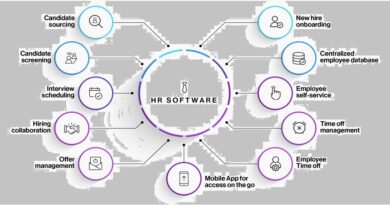Employee Success: The Role of Workforce HR Systems in Talent Development and Retention
In the contemporary business world, Fast Success has come to the forefront as an essential element responsible for organizational growth. Firstly, the core principles of the new paradigm incorporate the precise implementation of Workforce HR Systems, which should, consequently, be the pillar for talent management and the culture of retention. They are not only designed to simplify the administrative strategy but also provide a pathway for targeting individual development through customized programs. The utilization of highly advanced tech in HR is a means by which firms can prosper in an environment where not only will they secure the best talents, but a workforce that is resilient even in uncertainty, thus ensuring the organization is prepared for the ever-changing nature of the market.
The following paragraph will dwell on the key elements of employee success through a partnership between the workers and the workforce HR systems in talent development and retention. undefined
Strategic Talent Management: Creating Eco-System of Personal Growth
Strategic talent management is the backbone of the people’s development in an organization for the entire entity’s workforce. Through proper talent management strategies, the alignment with the fluctuating needs of the business can be achieved by developing employee skills continually. Today, HR systems take an active role in the control phase, having the necessary tools to identify high-potential employees based on performance indicators and predictive analytics. Upon having been identified, these candidates can gain from career development programs that are created to strengthen their abilities and develop them for suitable leadership in the future. Thus, such career development programs not only promote lifelong learning but also build the level of contentment at work and reduce the overall turnover rate.
The Effects of HR Systems on Workforce Recovery
Quite intelligible HR systems are a cornerstone of staff longevity and contentment. The candidate screening process becomes much easier when using such platforms. The platform selects only the candidates who have the best skills to cope with the company’s needs, thus building a more dedicated and motivated workforce right from the start. An example of that would be training modules in HR systems, which provide employees with in-service facilities and allow them to keep their skills polished and relevant. Performance monitoring systems play a role in identifying and rewarding employees for their efforts, making a company that respects its workforce.
Lastly, feedback mechanisms set in place a communication pathway through which employees can state their worries and complaints as well as make suggestions for better workplace conditions which can eventually lead to changes. Together, these features make a workplace that supports employees and their patterns, thereby creating their loyalty and readiness to thrive in this particular company.
Building a Resilient Workforce: Facilitating HR Tech Functions
Through HR technology, focusing on human capital remains critical to the creation of a workforce that can endure adverse conditions. Such technological instruments contribute to the achievement of competent talent management by mirroring performance management with the enterprise objectives, considering employees’ accomplishments. Learning systems present individualized growing opportunities with which the staff can gain new competencies and adjust to the new market beforehand.
On top of that, these systems support the labour engagement plans by ensuring that the message is communicated through the system, thus enabling feedback, which is key in retaining and developing the labour force. Using these technologies, employers can foster a dynamic working environment where workers will not only make their recruitment outstanding but also retain them.
Measuring Success: Indicators of soundness governing system for HR.
To track KPIs (key performance indicators) often, it is vital to evaluate the performance of the HR system. These metrics include:
Employee Engagement: The meaningfulness of the process can be identified through the number and attitude of survey respondents and the participation rate of the nomads in the HR (Human Resources) activities as their commitment and job satisfaction.
- Turnover Rates: Indicators of retention are defined as figures that regulate the employees, who have left the company, over the specific period in proportion with the total workforce.
- Skill Development: Bound by the outcome of workers enrolling in the training and the attainment of new qualifications and skills they are taking to work with.
These key indicators of effectiveness (KPIs) reflect the influence of the HR system on the human resource capital of the organization, and they show a clear strategic path to finetune the performance.
Creating a Culture of Continuous Learning: HR Services as Enabling Figures
Human resources (HR) crucially expedites the buildup of an organizational system of perpetual learning. These systems feature modern technologies and data analytics integration that can prioritize various learning experiences to the specific needs of individual employees, in turn, this ensures that the skills are enhanced as well as the employee’s growth. They are the sites where the notion of knowledge sharing occurs with the employee’s capability to contribute and learn being upgraded exponentially. Thus, they get to work as a team with their colleagues. By doing this, workers can see their career growth and ongoing development fit into the overall organizational strategy, which also fosters both innovation and adaptation to a business world constantly evolving itself.
Bear in mind therefore that an employee life cycle with retention and development is integrated with the entire HR ecosystem that supports employees throughout the stages of a journey in an organization.
Conclusion:
In summary, the contribution of Workforce HR Systems to developing and preserving the generational workforce is undeniable in today’s business world. These systems encompass a set of tools that are instrumental in improving employees’ learning experience, leading to higher engagement and the creation of a culture of continued learning. The use of HR technologies and the improvement of a set of metrics like the level of employee engagement, turnover rates and skill development will enable organizations to create a professional force which helps to drive organizational success. Creating a human resource system is not only about solving everyday things but about giving employees enough room to develop their full potential by supporting the organization’s goals. This is a wholesome approach that ensures that Staff Success becomes the synonym for organizational success.




